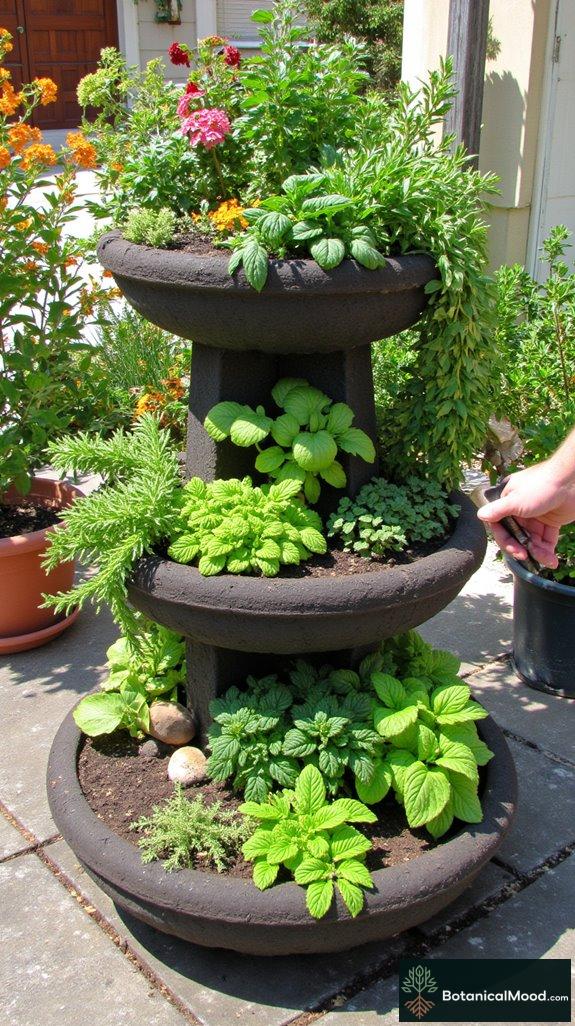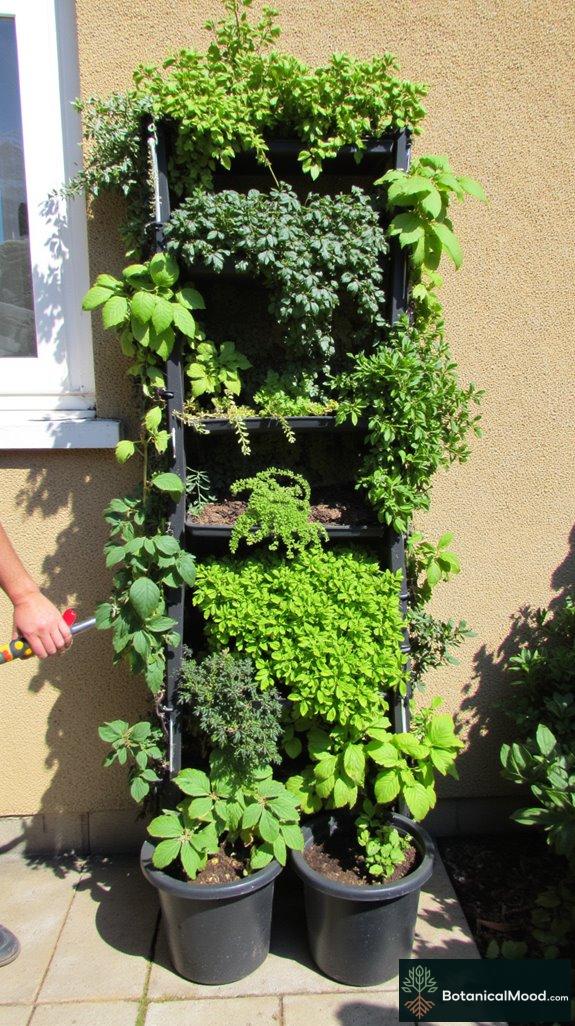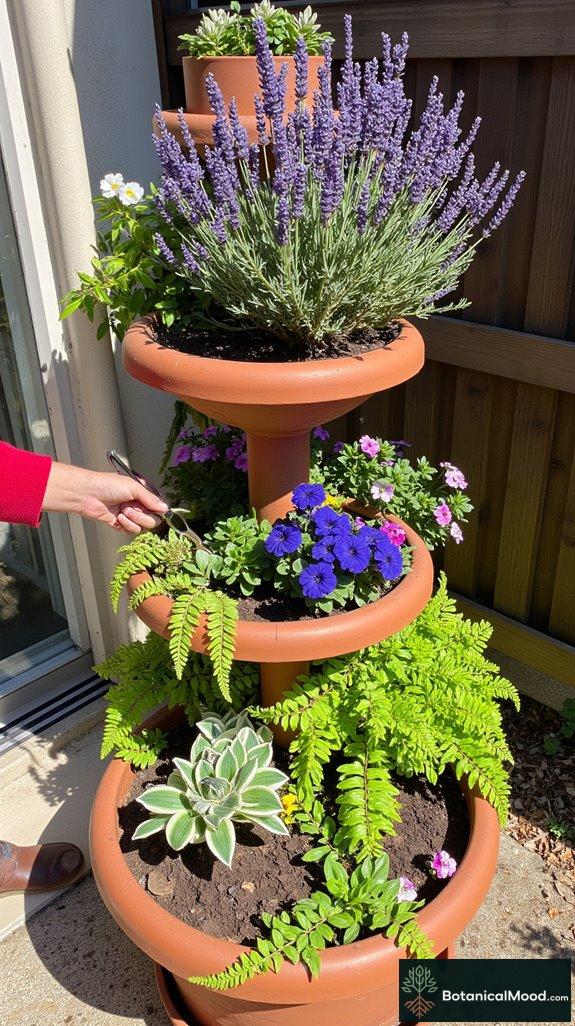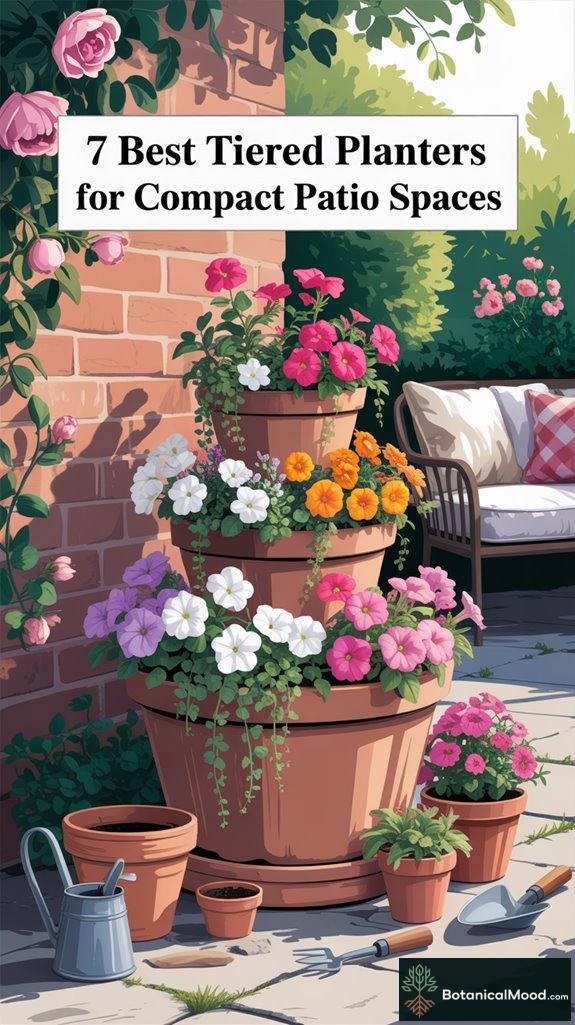Looking to squeeze a garden into your tiny patio?
Trust me, I’ve been there.
I tried cramming my collection of kitchen herbs into every nook and cranny. But then I discovered tiered planters! The Greenstalk Vertical Planter was a game-changer for my basil and strawberries. Who knew I could elevate my gardening ambitions—literally?
Plus, the Crescent Garden Orinoco is so stylish it could pass for a piece of modern art. And let’s not forget the ladder-style planters; who doesn’t want a mini garden tower? Each one brings something special to the table—or, uh, patio.
So, what’s stopping you from transforming your space?
Garden Design Revelation: My Vertical Gardening Journey
I once faced the challenge of dull, bland spaces in my apartment. In a bid to create a welcoming vibe, I ventured into tiered gardening. That’s when I stumbled upon vertical designs.
After countless attempts, I found joy in arranging colorful blooms with cascading herbs. The thrill of seeing my patio come alive was intoxicating; it felt like art! Gradually, my friends started visiting, eager to see this floral wonderland.
Now, my journey inspires others to play with garden layouts, mix textures, and create their own green retreats. If only I’d figured this out sooner!
Quick Takeaways
- Greenstalk Vertical Planters: Modular tiered design, gravity-fed watering system, and optimal for growing herbs and small vegetables in limited spaces.
- Crescent Garden Orinoco Planters: Durable materials, modern aesthetics, and excellent drainage make these planters perfect for flowers and trailing plants.
- Maximized Vertical Space: Tiered planters conserve ground space, allowing more plants to thrive in compact patios while enhancing visual appeal.
- Customizable DIY Options: Build your own multi-tier planters using wood, metal, or plastic to tailor fit your patio’s unique style and needs.
- Plant Selection Strategy: Opt for a mix of herbs, flowers, and vegetables that thrive together and benefit from vertical arrangements while maintaining required spacing.
Stacked Planters: Versatile DIY Solutions for Small Spaces

Stacked planters are an innovative solution designed for compact patios, maximizing vertical gardening space while adding aesthetic appeal.
These planters hinge on multi-level arrangements, often utilizing materials like wood, metal, or recycled plastic. Sizes can vary, typically ranging from 3 to 6 feet tall and 2 to 4 feet wide.
The layout allows for tiered placement of herbs, flowers, or small vegetables, creating a cascading effect that enhances visual interest. Construction is straightforward, often requiring minimal tools and basic assembly with screws or brackets. Incorporating stackable vertical garden beds can further optimize your gardening experience in limited spaces.
Tiered arrangements in stacked planters create visual interest while simplifying assembly with minimal tools.
Selecting Plants for Stacked Planters
When choosing plants for stacked planters, consider the light requirements, growth habits, and root depth.
Ideal plants for this setup include:
- Herbs: basil, thyme, oregano
- Vegetables: lettuce, strawberries, cherry tomatoes
- Flowers: petunias, marigolds, pansies
Designing Your Stacked Planter Bed
To design an effective stacked planter, consider the following tips:
- Space Planning: Plant taller species at the back or top tiers and shorter ones towards the front.
- Grouping Plants: Plant in groups of three for a balanced look.
- Consider Growth: Ascertain you account for the full growth of each plant to avoid overcrowding.
Pro Tips: Use a mix of textures and colors, and be mindful of watering needs when planning your layout.
Benefits of Vertical Gardening in Small Spaces
Vertical gardening through stacked planters not only conserves ground space but also provides a fresh supply of herbs and vegetables.
Enhancing your patio’s ambiance, it promotes sustainable gardening and maximizes sunlight exposure. Additionally, these planter systems encourage biodiversity, allowing beneficial insects to thrive in your garden ecosystem.
Vertical Planters: Maximizing Height and Growing Potential

Vertical planters are a perfect solution for compact patios, offering an effortless way to maximize limited space. These planters typically range from 4 to 6 feet in height and are available in various materials such as wood, metal, or plastic.
The multi-tiered design allows for a visually appealing arrangement, encouraging a diverse assortment of plants. Common plants used in these planters include herbs like basil and rosemary, vibrant flowers, and even compact vegetable varieties. Additionally, incorporating self-watering systems can enhance plant growth by ensuring consistent moisture.
Constructed using stacked tiers or wall-mounted frameworks, vertical planters provide excellent drainage and sunlight exposure, creating an inviting garden atmosphere.
How to Select Plants for Vertical Planters
When selecting plants for vertical planters, consider their light and water requirements. Here are some great choices:
- Herbs: Basil, Mint, Thyme
- Flowers: Petunias, Marigolds, Pansies
- Vegetables: Strawberries, Spinach, Cherry tomatoes
Designing Your Vertical Planting Bed
To design an appealing vertical planter, assess your space first. Here are key design tips:
- Choose the Right Location: Verify proper sunlight and accessibility.
- Layering: Position taller plants at the back and shorter ones in front.
- Spacing: Keep a distance of 6-12 inches for airflow.
- Pro Tip: Use trailing plants, like ivy or lobelia, to create cascading effects that soften hard edges.
Indoor Gardens: Bringing Nature Indoors
Indoor gardens are an effective way to enrich your living space. By incorporating potted plants, hydroponics, or even small vertical gardens, you can cultivate a serene atmosphere.
Choose low-light plants like snake plants or pothos for shaded areas and utilize grow lights for ideal growth indoors. Creating these green spaces can enhance air quality while providing an invigorating aesthetic to any room.
Garden Towers: Efficient Use of Space With Multi-Pocket Designs

Garden towers are innovative tiered planters ideal for compact patios, maximizing vertical space with their multi-pocket designs. Typically ranging from 3 to 5 feet in height and varying widths, these planters provide ample planting areas for herbs, vegetables, and flowers. Additionally, the modular design of garden towers allows for customized layouts, making it easy to fit them into any outdoor space.
Constructed from durable materials like UV-resistant plastic or wood, garden towers are designed to withstand outdoor elements. The tiered arrangement not only adds aesthetic appeal but guarantees efficient drainage and exposure to sunlight for all plants.
Garden towers, made from durable materials, ensure efficient drainage and sunlight exposure while enhancing outdoor aesthetics.
Selecting Plants for Garden Towers
To optimize your garden tower, choose plants based on size and sunlight needs. Ideal plants include:
- Basil
- Cherry tomatoes
- Strawberries
- Lettuce
- Petunias
These selections thrive in limited space while providing lush greenery and colorful blooms.
Designing Your Garden Tower
When designing your garden tower, consider these key aspects:
- Plan the layout: Group plants with similar sunlight requirements.
- Spacing: Allow adequate space for roots to grow; typically, 6-12 inches apart.
- Layering: Place taller plants at the top and shorter ones at the bottom for visual appeal.
Pro tip: Use companion planting for pest control and growth enhancement, choosing plants that benefit each other.
Companion Planting for Enhanced Growth
Companion planting is an excellent strategy for inexperienced and seasoned gardeners alike. By grouping compatible plants, you can encourage natural pest control and boost nutrient uptake, enhancing your garden’s resilience and productivity.
Ladder-Style Planters: Stylish and Functional for Compact Areas

Ladder-Style Planters: Stylish and Functional for Compact Areas
Ladder-style planters are ideal for compact patios, utilizing vertical space to create an eye-catching garden display. Typically made from wood or metal, these planters come in varying sizes, often forming a tiered ladder-like structure. Each tier features ample space for soil and drainage, allowing you to cultivate herbs, flowers, or even small vegetables.
The overall look is modern and stylish, seamlessly integrating with your outdoor decor. Construction usually involves sturdy frameworks for stability while guaranteeing easy access to each planting level. Additionally, incorporating small backyard garden fountains can further enhance the charm and tranquility of your outdoor retreat.
Choosing the Right Plants for Ladder Planters
When selecting plants for your ladder-style planters, consider their light and water needs. Opt for varieties that thrive in your specific climate and guarantee there’s a mix of sizes for visual appeal. Recommended plants include:
- Herbs: Basil, Mint, Thyme
- Flowers: Petunias, Marigolds, Lobelia
- Vegetables: Radishes, Lettuce, Cherry Tomatoes
Designing and Planning Your Ladder Planters
To design your ladder-style planters effectively, follow these tips:
- Choose a sturdy base to withstand weather elements.
- Arrange plants from tallest at the back to shortest at the front for visibility and sunlight exposure.
- Space plants according to their growth habits; larger plants require more room.
- Consider companion planting to enhance growth and pest control.
Caring for Your Compact Garden Space
Maintaining a compact garden space on your patio requires routine care and attention. Guarantee proper watering schedules, thin out overcrowded plants, and apply organic fertilizers for nutrient replenishment.
Regularly inspect for pests or diseases to guarantee peak growth. A vertical garden not only maximizes space but also adds visual interest to small areas.
Greenstalk Vertical Planters: Modular Options for Shallow-Rooted Plants

Greenstalk vertical planters are perfect for gardeners with compact patios and limited space. These modular planters come in towers ranging from 3 to 5 tiers, designed for shallow-rooted plants such as herbs, strawberries, and succulents. Constructed from durable, BPA-free plastic, they feature a gravity-fed watering system that guarantees even moisture distribution. The modular design allows for unique arrangements, making it easy to customize your setup for a prime look that complements your patio.
Additionally, the use of vertical gardening techniques can significantly enhance your small gardening space’s productivity and aesthetics.
Selecting Plants for Greenstalk Planters
When selecting plants for your Greenstalk vertical planters, consider their root depth and growth habits. Here are some great options:
- Basil
- Chives
- Spinach
- Cherry tomatoes
- Strawberries
- Lettuce
- Succulents
Designing Your Greenstalk Vertical Planter
To design an effective Greenstalk planter, follow these tips for layout and plant arrangement:
- Layer Plants by Size: Place taller plants at the top and shorter plants at the bottom.
- Consider Sunlight Needs: Position sun-loving plants in the upper tiers, while shadier varieties can thrive below.
- Create Contrast: Utilize a mix of colors and textures for visual interest.
Pro Tips:
- Space plants according to their mature size, typically 6-12 inches apart.
- Rotation of crops each season can rejuvenate your planter’s soil and health.
Benefits of Vertical Gardening Techniques
Vertical gardening offers numerous benefits, including maximizing space and improving air circulation.
Use adjustable shelves for versatility, and consider using trellises to support climbing plants. This method not only beautifies compact areas but also enhances yield in small gardens.
Crescent Garden Orinoco Planters: Durable and Insulated Choices

Crescent Garden Orinoco Planters are ideal for compact patios, making them the perfect choice for urban gardeners.
These tiered planters are made from durable materials that provide insulation, ensuring that your plants thrive in all weather conditions. Typically, they measure 24 inches in height and have a stylish, modern design that fits any outdoor space.
Constructed with multiple levels, you can arrange plants in a cascading layout, creating an eye-catching display. Suitable plants include herbs, succulents, and colorful flowering annuals. These planters also have excellent drainage capabilities, keeping plants healthy. Creative pergola decorations can enhance the overall aesthetic of your outdoor space when combined with tiered planters.
Selecting Plants for Tiered Planters
When selecting plants for your Crescent Garden Orinoco Planters, consider the following:
- Choose compact plants: Look for ceramics, herbs, or annuals.
- Consider sunlight: Assess the light requirements and select accordingly.
Suggested plants:
- Lavender
- Petunias
- Thyme
- Marigolds
- Sedum
Designing Your Tiered Planter Bed
To design your tiered planting bed effectively:
- Plan layout: Sketch a layout considering light and height.
- Use appropriate spacing: Leave room for air circulation.
- Group plants by their needs: Cluster by sunlight or watering needs.
Pro tips:
- Place taller plants at the back or top, with shorter varieties below.
- Use a color palette that complements your outdoor décor for visual appeal.
Enhancing Urban Gardening with Vertical Features
In addition to tiered planters, consider using vertical features such as trellises or wall-mounted planters.
These can help maximize space while providing support for climbing plants and adding visual interest to your patio design. Make sure to combine textures and colors for a stunning effect.
Creative DIY Ideas for Rental-Friendly Tiered Planters

Tiered planters are perfect for compact patios, allowing gardeners to maximize their growing space creatively. Typically, they come in multiple levels, accommodating a variety of plants while minimizing footprint. Common materials include wood, metal, or durable plastic, providing a sturdy structure.
Tiered planters creatively maximize compact patio space, featuring multiple levels for diverse plant varieties while minimizing footprint.
A standard size can range from 3 to 6 feet tall, with shelves spaced adequately to allow for plant growth and accessibility. Constructing a tiered planter involves stacking levels securely, using a trellis or support beams if needed. Fill each tier with a high-quality potting mix suited to the plants you choose, while ensuring proper drainage.
Selecting Plants for Tiered Planters
When selecting plants for tiered planters, consider your patio’s sun and shade conditions. Choose a mix of perennials and annuals for continuous bloom. Suggested plants include:
- Lavender
- Petunias
- Succulents
- Strawberries
- Ferns
Designing a Tiered Planter
To design a functional tiered planter, start with a strong base and visualize your layout. Follow these tips for effective arrangement:
- Place taller plants at the back or top tier.
- Use trailing plants on lower levels for a cascading effect.
- Space plants according to their mature size for ideal growth.
Pro tip: Group plants with similar watering needs or sunlight exposure together to maintain a healthy environment.
Enhancing Your Outdoor Living Space
Incorporating outdoor seating or decorative elements around your tiered planter can enhance the charm of your patio. Consider using comfortable furniture, string lights, or garden art to create a welcoming ambiance.
Fertilizer Application Schedule

To guarantee your tiered planters thrive, establishing a fertilization schedule is essential, especially since each plant group has different nutrient requirements.
I typically use balanced fertilizers, like 10-10-10 (N-P-K) for leafy greens and specialized types, such as high phosphorus options for flowering plants.
Application techniques vary—liquid fertilizers are fantastic for quick absorption, while granules provide slow-release nutrition.
I recommend applying fertilizers every four to six weeks during the growing season.
Don’t forget to monitor plant responses and adjust your schedule accordingly.
Summary
I’ve found that stacked planters and vertical designs truly transform my compact patio into a vibrant space. Exploring different tiers has allowed my favorite flowers and herbs to shine. Embracing this gardening journey has brought me so much joy and creativity.
I’d love to hear about your gardening experiences. What strategies have you used to make the most of your compact spaces?
Feel free to share pictures of your garden and tell me how you designed it!
References
- https://www.shelterness.com/tiered-planters-to-save-space/
- https://www.youtube.com/watch?v=ChIxUciMGy4
- https://www.thecountrychiccottage.net/diy-tiered-planter-pots-with-patio/
- https://www.parkseed.com/blogs/park-seed-blog/12-innovative-vertical-gardening-ideas-for-maximizing-small-spaces
- https://www.gardeningknowhow.com/garden-how-to/design/small-patio-ideas
- https://tagandtibby.com/blog/2023-4-22-15-rental-friendly-vertical-amp-raised-garden-ideas/
- https://www.eplanters.com/blog/15-ideas-for-landscaping-with-planters/

Leave a Reply